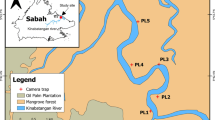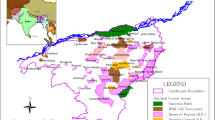Abstract
Knowledge on the occurrence and distribution of species is crucial for designing and evaluating conservation strategies within a geographical region. Similipal Tiger Reserve though confined to a small area needs information on the diversity and abundance of mammalian fauna to ensure conservation of tiger. Thus, we aimed to assess the diversity and abundance of medium to large sized mammals in Similipal Tiger Reserve by using remotely triggered camera traps. A total of 6413 camera trap days at 187 trap stations were deployed from November 2012 to July 2013 to estimate the status of mammal. We obtained 3763 independent photographs and detected 24 species of mammals. The relative abundance index of each mammalian species was calculated. Leopard (Panthera pardus) was the most abundant carnivore while barking deer (Muntiacus muntjac) was the most abundant prey. Anthropogenic activities like hunting, livestock grazing and free ranging domestic dogs were found to be the detrimental factors for the existing mammalian species. These activities should be addressed through conservation and development perception with an interdisciplinary approach, incorporating social and ecological components cautiously.




Similar content being viewed by others
References
Ahumada, J.A., C.E.F. Silva, K. Gajapersad, H. Chris, H. Johanna, M. Emanuel, A. McWilliam, B. Mugerwa, T. O’Brien, F. Rovero, D. Sheil, W.R. Spironello, N. Winarni, and S.J. Andelman. 2011. Community structure and diversity of tropical forest mammals: Data from a global camera trap network. Philosophical Transaction of Royal Society B 366: 2703–2711. doi:10.1098/rstb.2011.0115.
Annon. (2012). Annual Report. Similipal Tiger Reserve, Odisha, India.
Berger, K.M., E.M. Gese, and J. Berger. 2008. Indirect effects and traditional trophic cascades: A test involving wolves, coyotes and pronghorn. Ecology 89: 818–828.
Carbone, C., S. Christie, K. Conforti, T. Coulson, N. Franklin, J.R. Ginsberg, M. Griffiths, J. Holden, K. Kawanishi, M. Kinnaird, R. Laidlaw, A. Lynam, D.W. Macdonald, D. Martyr, C. McDougal, L. Nath, T. O’Brien, J. Seidensticker, D.J.L. Smith, M. Sunquist, R. Tilson, and W.N. Wan Shahruddin. 2001. The use of photographic rates to estimate densities of tigers and other cryptic mammals. Animal Conservation 4(1): 75–79.
Chauhan, D.S., Singh R., Mishra S.,Dadda T., and Goyal. S.P. (2006). Estimation of tiger population in an intensive study area of Pakke tiger reserve, Arunachal Pradesh, India. Unpublished Report. Wildlife Institute of India, Dehradun, India.
Datta, A., M.O. Anand, and R. Naniwadekar. 2008. Empty forests: Large carnivore and prey abundance in Namdapha National Park, north-east India. Biological Conservation 141: 1429–1435. doi:10.1016/j.biocon.2008.02.022.
IUCN. 2013. Red List of Threatened Species. Gland, Switzerland: Species Survival Commission (SSC), IUCN.
Jennelle, C.S., M.C. Runge, and D.I. Mackenzie. 2002. The use of photographic rates to estimate densities of tigers and other cryptic mammals: A comment on misleading conclusions. Animal Conservation 5: 119–120. doi:10.1017/S1367943002002160.
Karanth, K.K., J.D. Nichols, J.E. Hines, K.U. Karanth, and N.L. Christensen. 2009. Patterns and determinants of mammal species occurrence in India. Journal of Applied Ecology 46: 1189–1200. doi:10.1111/j.1365-2664.2009.01710.
Karanth, K.K., J.D. Nichols, K.U. Karanth, J.E. Hines, and N.L. Christensen. 2010. The shrinking ark: Patterns of large mammal extinctions in India. Proceedings of Royal Society of London B 277: 1971–1979. doi:10.1098/rspb.2010.0171.
Karanth, K.U., and J.D. Nichols. 1998. Estimation of tiger densities in India using photographic captures and recaptures. Ecology 79: 2852–2862.
Karanth, K.U. 1995. Estimating Panthera tigris populations from camera-trap data using capture–recapture models. Biological Conservation 71: 333–338.
Lacerda, A.C.R., W.M. Tomas, and J. Marinho. 2009. Domestic dogs as an edge effect in the Brasilia National Park, Brazil: Interactions with native mammals. Animal Conservation 12: 477–487.
Loveridge, A.J., S.W. Wang, L.G. Frank, and J. Seidensticker. 2010. People and wild felids: Conservation of cats and management of conflicts. In Biology and conservation of wild felids, ed. D.W. Macdonald, and A.J. Loveridge, 161–195. Oxford: Oxford University Press.
Mackenzie, D.I., J.D. Nichols, G.B. Lachman, S. Droege, J.A. Royle, and C.A. Langtimm. 2002. Estimating site occupancy rates when detection probabilities are less than one. Ecology 83: 2248–2255.
Madhusudan, M.D. 2004. Recovery of wild large herbivores following livestock decline in a tropical Indian wildlife reserve. Journal of Applied Ecology 41: 858–869.
Madhusudan, M.D., and C. Mishra. 2003. Why big, fierce animals are threatened: Conserving large mammals in densely populated landscapes. In Battles over nature:Science and the politics of conservation, ed. V. Saberwal, and M. Rangarajan, 31–55. New Delhi: Permanent Black.
Majumder, A., K. Sankar, and Q. Qureshi. 2013. Co-existence patterns of large sympatric carnivores as influenced by their habitat use in a tropical deciduous forest of Central India. Journal of Biological Research- Thessaloniki 19: 89–98.
Mathai, M. 1999. Habitat occupancy across anthropogenic disturbances by sympatric ungulate species in Panna Tiger Reserve. MSc thesis, Saurashtra University, Rajkot, India.
Mohapatra, P.P., H.S. Palei, and S.A. Hussain. 2014. Occurrence of Asian small-clawed otter Aonyx cinereus (Illeger, 1815) in Eastern India. Current Science 107(3): 367–370.
O’Brien, T.G., M.F. Kinnaird, and H.T. Wibisono. 2003. Crouching tigers, hidden prey: Sumatran tiger and prey populations in a tropical forest landscape. Animal Conservation 6: 131–139. doi:10.1017/S1367943003003172.
Peres, C.A. 2010. Effects of subsistence hunting on vertebrate community structure in Amazonian forests. Conservation Biology 14: 240–253.
Peres, C.A., and P.M. Dolman. 2000. Density compensation in neotropical primate communities: Evidence from 56 hunted and non-hunted Amazonian forests of varying productivity. Oecologia 122: 175–189.
Pollock, K.H., J.D. Nichols, T.R. Simons, G.L. Farnsworth, L.L. Bailey, and J.R. Sauer. 2002. Large scale wildlife monitoring studies: Statistical methods for design and analysis. Environmetrics 13: 105–119.
Ramesh, T., R. Kalle, K. Sankar, and Q. Qureshi. 2012. Spatio-temporal partitioning among large carnivores in relation to major prey species in Western Ghats. Journal of Zoology 287: 269–275. doi:10.1111/j.1469-7998.2012.00908.x.
Rovero, F., and A.R. Marshall. 2008. Camera trapping photographic rate as an index of density in forest ungulates. Journal of Applied Ecology 46: 1011–1017. doi:10.1111/j.1365-2664.2009.01705.x.
Silva-Rodríguez, E.A., and K.E. Sieving. 2012. Domestic dogs shape the landscape-scale distribution of a threatened forest ungulate. Biological Conservation 150: 103–110. doi:10.1016/j.biocon.2012.03.008.
Silva-Rodriguez, E.A., G.R. Ortega-Solis, and J.E. Jimenez. 2010. Conservation and ecological implications of the use of space by chilla foxes and free-ranging dogs in a human-dominated landscape in Southern Chile. Austral Ecology 35: 765–777. doi:10.1111/j.1442-9993.2009.02083.x.
Singh, G.S., and L. Gibson. 2011. A conservation success story in the otherwise dire mega fauna extinction crisis: The Asiatic lion (Panthera leopersica) of Gir forest. Biological Conservation 144: 1753–1757. doi:10.1016/j.biocon.2011.02.009.
Treves, A., P. Mwina, A.J. Plumptre, and S. Isoke. 2010. Camera trapping forest-woodland wildlife of Western Uganda reveals how gregariousness biases estimates of relative abundance and distribution. Biological Conservation 143: 521–528. doi:10.1016/j.biocon.2009.11.025.
Trolle, M., and M. Ke´ry. 2005. Camera-trap study of ocelot and other secretive mammals in the northern Pantanal. Mammalia 69: 405–412.
Vanak, A.T., and M.E. Gompper. 2010. Interference competition at the landscape level: the effect of free-ranging dogs on a native mesocarnivore. Journal of Applied Ecology 47: 1225–1232. doi:10.1111/j.1365-2664.2010.01870.x.
Wikramanayake, E.D., E. Dinerstein, J.G. Robinson, K.U. Karanth, A. Rabinowitz, D. Olson, T. Mathew, P. Hedao, M. Conner, G. Hemley, and D. Bolze. 1998. An ecology-based method for defining priorities for large mammal conservation: The tiger as case study. Conservation Biology 12: 865–878.
Wright, S.J., and H.C. Duber. 2001. Poachers and forest fragmentation alter seed dispersal, seed survival, and seedling recruitment in the palm Attalea butyraceae, with implications for tropical tree diversity. Biotropica 33: 583–595.
Acknowledgments
This study was made possible by a grant from the Director, Similipal Tiger Reserve. We are also thankful to the Odisha Forest Department for kind permission and co-operation to execute the work. We appreciate Alolika Sinha, Subrat Debata and Manish Bakshi for valuable inputs in the manuscript. We thank the anonymous reviewers for their critical review and suggestions which improved this manuscript.
Author information
Authors and Affiliations
Corresponding author
Rights and permissions
About this article
Cite this article
Palei, H.S., Pradhan, T., Sahu, H.K. et al. Estimating Mammalian Abundance Using Camera Traps in the Tropical Forest of Similipal Tiger Reserve, Odisha, India. Proc Zool Soc 69, 181–188 (2016). https://doi.org/10.1007/s12595-015-0143-x
Received:
Revised:
Accepted:
Published:
Issue Date:
DOI: https://doi.org/10.1007/s12595-015-0143-x




